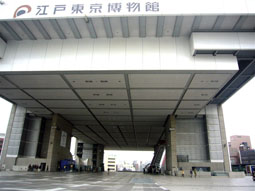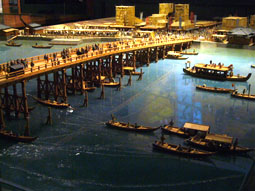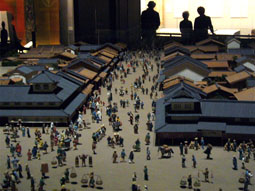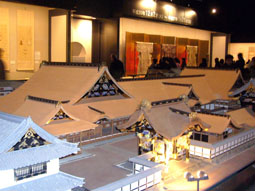 |
|
Here and There introduces art, artists, galleries and museums around Japan that non-Japanese readers and first-time visitors may find of particular interest. The writer claims no art expertise, just a subjective viewpoint acquired over many years' residence in Japan.
|
|
 |
|
|
 |
 |
Everything You Wanted to Know About This Town: The Edo-Tokyo Museum
Alan Gleason |
|
 |
|
 |
Tiny earthlings prepare to board the Edo-Tokyo Mother Ship.
|
|
Scale model of the Ryogoku Bridge; the museum and the Sumo Arena now occupy the site across the river. |
It is an intimidating edifice, hovering ominously over the Sumo Arena next door like a cross between a medieval Japanese castle and an alien star cruiser. In fact, it is built to resemble an old kurazukuri-style elevated storehouse. But as you are transported upward into its vast belly on the space-age red escalator, it feels like you are about to blast off for a distant planet.
Though not quite as intergalactic as all that, the museum is certainly big enough to swallow you up into its own world. The main exhibition hall alone could hold Disneyland's Space Mountain twice over, and there is definitely an amusement park vibe to the place. Instead of rides, however, you get such marvels as:
- a full-size replica of old Edo's Nihonbashi Bridge to walk across
- a room-size model of a typical Edo merchants' quarter
- another monster model of a Shogun-era daimyo's palace
- a Kabuki theater with life-size actor dolls
And so on. You get the idea.
Though the museum strives to devote equal space to Edo (the city's name as seat of the Tokugawa Shogunate from 1603 to 1868) and Tokyo (the post-Shogunate "Eastern Capital" of the country), the Edo half is definitely the most fun. Massive and meticulously rendered exhibits like the above offer vivid glimpses of life in urban Japan while it was still isolated (intentionally) from the rest of the world. A sleepy fishing village when the first Shogun, Tokugawa Ieyasu, decided to make it his stronghold, Edo quickly grew into a thriving metropolis of one million that was, at the time, the biggest city in the world.
But the Tokyo side, which highlights the breakneck modernization the re-named capital embarked upon 140 years ago -- when Japan opened its doors to foreign commerce, the Shogunate fell, and the emperor moved his palace there from Kyoto -- is fascinating in its own right. Sobering, in fact. Though the replicas of rococo Meiji-era Victorian and art-deco buildings are quaint enough, what really catch the eye are the displays that graphically illustrate Tokyo's two great disasters of the past century: the 1923 Kanto Earthquake and the 1945 firebombing of the city by U.S. B-29s. The two events are eerily similar: about 100,000 lives lost in a matter of hours, nearly all by fire. Nope, Disneyland this ain't.
Within its cavernous confines the museum has plenty of room for side galleries containing numerous special exhibitions. A recent show featured a hallful of kago, the ornate palanquins used to carry nobility during the Edo period. Covered in gorgeous brocade and lacquerwork, surely no mode of transport has been so lavishly decorated before or since. The only contemporary parallels that come to mind are the wacky "art cars" of California.
Spaceship analogies aside, the Edo-Tokyo Museum is definitely worth the trip up that weird escalator if you are ready to spend the better part of a day immersing yourself in the variegated history of this 400-year-old megalopolis. At only 600 yen, it's a far better bargain than any amusement park.
 |
|
 |
| Street scene in an Edo merchants' neighborhood, replete with tiny people, horses, and palanquins. |
|
Model of Lord Matsudaira's residence in Edo.
All photos by Alan Gleason, by permission of the Edo-Tokyo Museum |
|
|
|
|
 |
 |
|
 |
Edo-Tokyo Museum |
 |
|
|
1-4-1 Yokoami, Sumida-ku, Tokyo
Phone: 03-3626-9974
Open 9:30-5:30 (Saturday until 7:30), closed Mondays and December 28 - January 1
Transportation: 3 minutes walk from Ryogoku Station on the JR Sobu and Toei Oedo Lines |
 |
|
|
 |
 |
Alan Gleason
Alan Gleason is a translator, editor and writer based in Tokyo, where he has lived for 24 years. In addition to writing about the Japanese art scene he has edited and translated works on Japanese theater (from kabuki to the avant-garde) and music (both traditional and contemporary). |
|
|
|
 |
 |
|